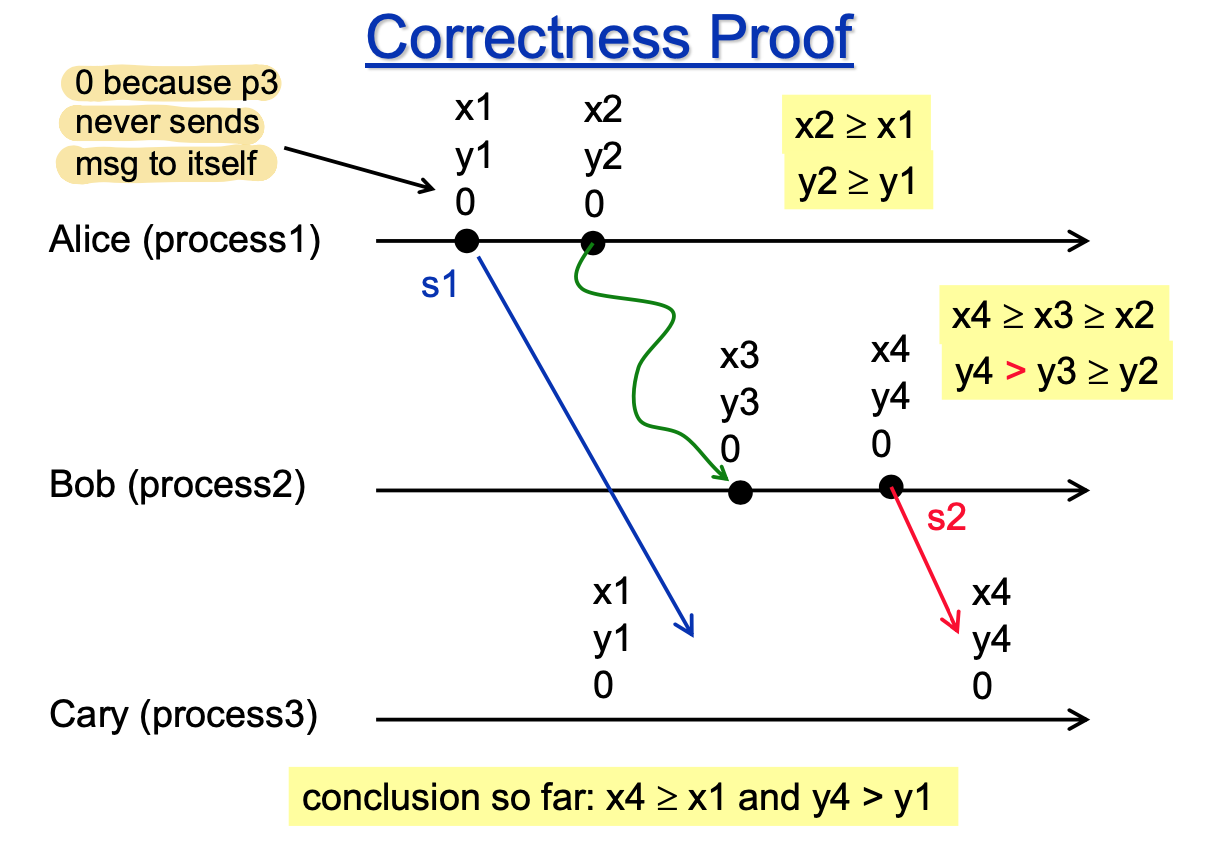Causal Order
- If s1 happened before s2, and r1 and r2 are on the same process, then r1 must be before r2
If on different process, then don’t care
Causal Ordering Protocol
Each process maintains n by n matrix M
- This is not the matrix clock
- M[i, j]: # of messages sent from i to j, as known by process i
If process i send a message to process j
- On process i: M[i, j]++;
- Piggyback M on the message
Upon process j receiving a message from process i with matrix T piggybacked
- Let M be the local matrix on process j
Deliver the message and set M = pairwise-max(M, T), if
-
T[k, j] ≤ M[k, j] for all k ≠ i
Implies that there is no message missing
-
T[i, j] = M[i, j] + 1
Ensure FIFO ordering of messages that are sent by process i
Only compare receiver column
Correctness Proof
s1, s2, r1, r2, where s1 happened before s2
Need to prove
-
r1 is never delivered after r2

Assume Red delivered before Blue
After delivering Red:
M = ≥ x4 ≥ x1
≥ y4 > y1
0
M never decreases: Blue can never be delivered any more, because the condition M[1, 3] = x1 - 1 cannot be satisfied
-
both r1 and r2 will eventually be delivered
Causal Ordering Broadcast Protocol
Each process maintains a message log for all messages delivered
- When sending a message, append the message to log and send the whole log
- Upon receiving a log, scan the log sequentially, for any message not seen before: Append the message to local log and deliver it
This method is practical because it is for broadcast messages, the overhead is smaller.
Total Ordering of Broadcast Messages (Atomic Broadcast)
Total ordering is only applicable to broadcast messages.
All messages delivered to all processes in exactly the same order
Total ordering and causal ordering do not imply each other.
Using a coordinator for total order broadcast
A special process is assigned as the coordinator
To broadcast a message
- Send a message to the coordinator
- Coordinator assigns a sequence number to the message
- Coordinator forward the message to all processes with the sequence number
- Messages delivered according to sequence number order
Problem
- Coordinator is performance bottleneck
- What if coordinator fails
Skeen’s Algorithm for Total Order Broadcast
Each process maintains logical clock and a message buffer for undelivered messages
A message in the buffer is delivered / removed if
- All messages in the buffer have been assigned numbers
- This message has the smallest number
Claims
-
All messages will be assigned message numbers
No blocking
-
All messages will be delivered
Based on the assumption that all process stop sending messages
-
If message A has a number smaller than B, then B is delivered after A
Proof
-
Suppose A is delivered on process 3 after B
-
Then A must have been placed in buffer after B was delivered
Because otherwise the max clock value will be the same, which will result in A and B having the same number, cannot guarantee that A is delivered after B
- A must have a number larger than B
-